Chinatown, Toronto
| Chinatown, Toronto 多倫多華埠 | |
|---|---|
| Neighbourhood | |
|
Chinatown along Spadina Avenue | |
 Location within Toronto | |
| Coordinates: 43°39′10″N 79°23′53″W / 43.6529°N 79.3980°WCoordinates: 43°39′10″N 79°23′53″W / 43.6529°N 79.3980°W | |
| Country |
|
| Province |
|
| City |
|
Chinatown (Chinese: 多倫多華埠) is an ethnic enclave in Downtown Toronto, Ontario, Canada, with a high concentration of ethnic Chinese residents and businesses extending along Dundas Street West and Spadina Avenue west of the centre of the city. A second area known as East Chinatown, extends along both streets from the intersection of Broadview Avenue and Gerrard Street. Originating in what used to be known as The Ward in the early 20th century and then migrating west to Spadina, the main Chinatown is now one of the largest Chinatowns in North America and one of several major Chinese-Canadian communities in the Greater Toronto Area. There are approximately six Chinatowns in Greater Toronto, including in the municipalities of Markham and Mississauga.
History
Toronto's Chinatown first appeared during the 1890s with the migration of American Chinese from California due to racial conflict and from the Eastern United States due to the economic depression at the time.[1] The earliest record of Toronto's Chinese community is traced to Sam Ching, who owned a hand laundry business on Adelaide Street in 1878.[2] Ching was the first Chinese person listed in the city's directory[3] and is now honoured with a lane named after him.[4] The first Chinese cafe opened in 1901 and that number grew to 19 in 1912 and to around 100 a decade after that.[5]
Toronto's downtown Chinatown has two phases in its history since inception:
- First Chinatown (1870s–1961): The original Chinatown was centred near present-day Elizabeth and Hagerman street (43°39′14″N 79°23′06″W / 43.654°N 79.385°W). Situated in what was then known as "The Ward", one of the city's largest slum areas for incoming immigrants, the area was expropriated and razed in 1955, despite myriad protests to make way for Toronto New City Hall and Nathan Phillips Square. More than three-quarters of the neighbourhood was commandeered as a result of the forced dispossession.
- Old Chinatown (1950s–Present): The present downtown Chinatown is centred at Spadina Avenue and Dundas street (43°39′11″N 79°23′53″W / 43.653°N 79.398°W). Although a small Chinese community was already present in this location prior to the 1950s, the "old" Chinatown was formed mainly when businesses with the financial ability moved from the First Chinatown to the Spadina location.
First Chinatown
The first Chinatown of Toronto existed in the 1890s along York Street and Elizabeth Street between Queen and Dundas Streets within Toronto's Ward district. Most of the space is now occupied by the new Toronto City Hall and its civic square, Nathan Phillips Square, with only one third of this original Chinatown left south of Dundas.
Even with the strict limitations placed on Chinese immigration with the Chinese Immigration Act of 1885, the first Toronto Chinatown took shape in the early 1900s as hundreds of Chinese men settled close to Union Station after helping to build the Canadian Pacific Railway across Canada. The men originally found lodgings close to the railway station due to its convenience.[6]
_-_Quartier_chinois_de_Toronto%2C_Ontario.jpg)
By 1910, the Chinese population in Toronto numbered over a thousand. As in the rest of Canada and the US, due to entry resistance into other areas of employment the Chinese of Toronto had to resort to the labour of food service and washing laundry.[1] In this time, hundreds of Chinese-owned businesses had developed, consisting mainly of restaurants, grocery stores and hand laundries. The Chinese laundries competed with the other Torontonian laundries leading to publicly called boycotts and demands for the city government to cancel or withhold business licenses from Chinese operators.[1]
The first Chinese café (the term referred to Chinese owned establishments that served a combination of western and Chinese food) in Toronto was opened in 1901 at 37 1/2 Queen Street West opposite City Hall. By 1912, there were 19 Chinese restaurants, half of which were in The Ward. By the early 1920s, this figure had risen to around 100 cafés and restaurants.[7]
The growth of Chinatown prompted a moral panic among moral reformers and xenophobes who warned of the "lure of the Chinaman" and accused Chinese businesses of being dens of iniquity linked with opium and "white slavery" and of being a danger to the community and, in particular, to white women. As a result, in 1908 the city threatened to deny licenses to Chinese restaurants that employed white women and in 1914 the provincial government introduced legislation barring white women from working in Chinese restaurants. The legislation was not well enforced and by 1923 there were 121 white women recorded as being in the employ of 121 Chinese restaurants in Toronto.[7]
The Toronto Police regularly raided Chinese restaurants for alleged alcohol and gambling offences, particularly after the passage of the Canada Temperance Act in 1916.[7]
By the 1930s, Chinatown was a firmly established and well-defined community that extended along Bay Street between Dundas Street and Queen Street West. Like the rest of the country, Chinatown suffered a severe downturn in the Great Depression, with the closing of more than 116 hand laundries and hundreds of other businesses.[8]
Many Chinese restaurants in the area fell into disrepair in the 1940s, however the community began to recover after World War II as Canada's general economic fortunes improved and Elizabeth Street experienced a restaurant boom in the late 1940s and 1950 with new, large facilities such as the Nanking opening in 1947, and Lichee Garden Restaurant and Club opening in 1948. Both establishments catered to a largely western clientele with the Lichee Garden being able to accommodate 1,500 customers a day and offering dining and dancing with a live band and a closing time of 5 a.m.[7] Other large restaurants such as the Kwong Chow, the Golden Dragon and Sai Woo opened in the 1950s with millions of dollars being spent by Chinese investors on improvements to Elizabeth Street.[7]
Regardless of the investment by its owners and the success of the area with customers, plans emerged in the late 1950s to construct the new Toronto City Hall at the intersection of Queen and Bay Streets, it became clear that most of Chinatown would be displaced by the project. As Chinese businesses began to relocate west down Dundas and up Spadina Avenue around Kensington Market, some stores were taken over by other developers, and most stores that occupied the project site were cleared through expropriation. More than two-thirds of Elizabeth Street from Queen to Dundas Streets were destroyed. Construction on City Hall and Nathan Phillips Square began in 1961.
Due in part to the high land value in the area of Chinatown, city planners in 1967 proposed that the rest of the first Chinatown be demolished and the population moved for the development of office buildings north of City Hall. This endangered many more businesses, and even with the support of most Torontonians to save this part of Chinatown, the city was adamant to clear the buildings arguing that preserving Chinatown would turn it into a ghetto.[1] At this time, community leaders including Jean Lumb established the "Save Chinatown Committee", with Lumb acting as coordinator and face of the campaign. She later received the Order of Canada in 1976 for her role in helping to save Chinatown. In 1970 and again in 1975, city officials proposed to demolish the Dundas Street portions of Chinatown for the expansion of the street to six lanes, however due to community protests the proposals were quashed.[1]
More recently, the Dundas and Bay Street area, west to University Avenue, has been developing into a Little Tokyo district though several Chinese establishments remain on the block as well.[9]
Old Chinatown
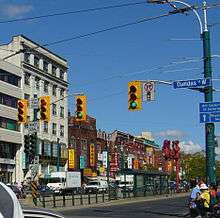
The present day old Chinatown along Spadina was formerly a Jewish district. With the influx of Chinese immigration during the 1960s due to the lifting of Canada's racial exclusion policies, along with much of the Jewish population moving north along Bathurst Street, Chinese businesses expanded in this area.[1]
Following the demolition of first Chinatown to make way for Toronto City Hall, the Chinese community migrated westward to the neighbourhood around Spadina Avenue and Dundas Street West. A handful of Chinese businesses still remain around Bay and Dundas and Elizabeth and Dundas but many have disappeared over time. Today, Chinatown primarily runs north-south along Spadina Avenue to College Street to Sullivan Street and east-west along Dundas Street West from Augusta Avenue to Beverley Street.
The Chinese population greatly increased as the wives and descendants of the Chinese men already in Canada immigrated to the city after the country's Chinese exclusion act was lifted in 1967.[1] In the following decades, students and skilled workers arrived from Hong Kong, Guangdong and Chinese communities in Southeast Asia and the Caribbean further increased the Chinese population which led to the creation of additional Chinese communities east of Toronto.
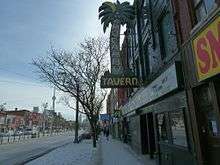
The El Mocambo live music venue is in the northern end of Chinatown, although this establishment was there before the neighbourhood became Chinatown.
The 510 Spadina streetcar route runs through Chinatown as well.
Economy
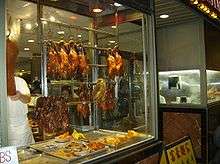
Toronto's Chinatown is one of the largest in North America. It is centred on the intersection of Dundas Street West and Spadina Avenue, and extends outward from this point along both streets. With the population changes of recent decades, it has come to reflect a diverse set of East Asian cultures through its shops and restaurants, including Chinese, Vietnamese, and Thai. The major Chinese malls in the area are Dragon City and Chinatown Centre.
Since the 1990s, Chinatown has been struggling to redefine itself in the face of an ageing Chinese population and the declining number of tourists visiting the enclave. As the ageing population shrank, revenues of businesses in the neighbourhood also decreased. While the majority of the grocery stores and shops remain, most of the once-famed restaurants on Dundas Street West, especially the barbecue shops located below grade, have closed since 2000.
Competition from commercial developments in suburban Chinese communities also drew wealth and professional immigrants away from downtown. Unlike those newer developments in the suburbs, Chinatown's economy relies heavily on tourism and Chinese seniors. As many younger, higher-income immigrants settled elsewhere in the city, those left in the district are typically from older generations who depend on downtown's dense concentration of services and accessibility to public transportation.
In the early 21st century, downtown neighbourhoods became more attractive to urban professionals and young people who work in the Financial District, as well as its proximity to the University of Toronto, leading to the gentrification of surrounding areas and potentially changing the face of old Chinatown.
Demographics

Historically, Toronto's Chinatown has been represented by immigrants and families from southern China and Hong Kong. Since the transfer of Hong Kong's sovereignty to the People's Republic of China in 1997, immigrants from mainland China have greatly exceeded those from Hong Kong. However, at present Cantonese remains the primary language used by businesses and restaurants in Chinatown. The Chinese immigrant population now consists of distinct subgroups: while some Vietnamese Chinese, who generally arrived as impoverished refugees, continue to reside in old Chinatown, others now live in suburban Mississauga; the wealthy Hong Kong Chinese now tend to settle in Markham and Richmond Hill. Among new immigrants, those who settle in the historic Chinatown tend to be Mainland Chinese.
To the east of Spadina Avenue, numerous university students attending the University of Toronto, OCAD University (formerly the Ontario College of Art and Design), and Ryerson University live in many of the small houses built as workers' housing. The diversity brings a more multicultural flavour to the district, but it may gradually reduce or eliminate its identity as Chinatown.
Translation of street names
A number of streets in Chinatown are bilingual, a feature first introduced in the 1970s. The translations are mainly phonetic and use Chinese characters defined through Cantonese pronunciations.
- Augusta Avenue - 澳吉士打道 (Jyutping: ou3 gat1 si6 daa2 dou6)
- Baldwin Street - 寶雲街 ( Jyutping: bou2 wan4 gaai1)
- Beverley Street - 比華利街 (Jyutping: bei2 waa4 lei6 gaai1)
- Bulwer Street - 寶華街 ( Jyutping: bou2 waa4 gaai1)
- Cameron Street - 卡梅隆街 (Jyutping: kaa1 mui4 ling4 gaai1)
- Cecil Street - 施素街 (Jyutping: si1 sou3 gaai1)
- College Street - 書院街 ( Jyutping: syu1 jyun2 gaai1)
- D’Arcy Street - 達士街 ( Jyutping: daat6 si6 gaai1)
- Dundas Street West - 登打士西街 (Jyutping: dang1 daa2 si6 sai1 gaai1)
- Glasgow Street - 嘉士高街 (Jyutping: gaa1 si1 gou1 gaai1)
- Grange Avenue - 固連治道 (Jyutping gu3 lin4 zi6 dou6)
- Grange Place - 固連治坊 (Jyutping: gu3 lin4 zi6 fong1)
- Grange Road - 固連治路 (Jyutping: gu3 lin4 zi1 lou6)
- Henry Street - 亨利街 (Jyutping hang1 lei6 gaai1)
- Huron Street - 曉倫街 (Jyutping: hiu2 leon4 gaai1)
- John Street - 約翰街 (Jyutping: joek3 hon6 gaai1)
- Kensington Avenue - 京士頓道 (Jyutping: ging1 si6 deon6 dou6)
- McCaul Street - 麥歌盧街 (Jyutping: mak6 go1 lou4 gaai1)
- Nassau Street - 拿素街 (Jyutping: naa1 sou3 gaai1)
- Oxford Street - 牛津街 (Jyutping: ngau4 zeon1 gaai)
- Phoebe Street - 菲比街 (Jyutping: fei1 bei2 gaai1)
- Queen Street West - 皇后西街 (Jyutping: wong4 hau6 sai1 gaai1)
- Renfrew Place - 温富坊 (Jyutping: wan1 fu3 fong1)
- Ross Street - 羅士街 (Jyutping: lo4 si6 gaai1)
- Saint Andrew Street - 聖安德魯街 (Jyutping: sing3 on1 dak1 lou5 gaai1)
- Soho Street - 蘇豪街 (Jyutping; sou1 hou4 gaai1)
- Spadina Avenue - 士巴丹拿道 (Jyutping: si6 baa1 daan1 naa1 dou6)
- Stephanie Street - 史蒂芬尼街 (Jyutping: si2 dai3 fan1 nei4 gaai1)
- Sullivan Street - 蘇利雲街 (Jyutping: sou1 lei6 wan4 gaai1)
East Chinatown

As property values increased in downtown Chinatown, many Chinese Canadians migrated to Toronto's east end in Riverdale. A second, somewhat smaller, Chinese community was formed, beginning in 1971 with the opening of Charlie's Meat.[10] Centred on Gerrard Street East between Broadview Avenue and Carlaw Avenue 43°40′00″N 79°20′50″W / 43.666614°N 79.347295°W, Chinese-Vietnamese and mainland Chinese immigrants dominate this district. Known as East Chinatown,[11] it covers a smaller area than Toronto's main Chinatown west of downtown, but is growing. At the northernmost corner of East Chinatown (northwest corner, Broadview Avenue and Gerrard Street) is the Riverdale branch of the Toronto Public Library. This branch is bilingual in Chinese and English. North of the library is the monument to Sun Yat-sen. East Chinatown can be accessed by the 504 King, the 505 Dundas, or the 506 Carlton Toronto Transit Commission (TTC) streetcars. Construction on the Toronto Chinese Archway began in the western end of East Chinatown on November 24, 2008 and it opened to the public on September 12, 2009. There are only two streets with bilingual signs (English on top, Chinese on the bottom), Broadview Avenue (百樂匯街) and Gerrard Street East (芝蘭東街), and signs located three of the four corners of the intersection.
In popular culture
Bo Ling's Chop Suey Palace in Metro-Goldwyn-Mayer's 1983 film A Christmas Story where the Parker family eat peking duck on Christmas Day was filmed here.[12]
The 1999 Chow Yun-fat film The Corruptor was set in the New York City Chinatown, with scenes filmed in the Chinatowns of New York and Toronto.
The television series Kung Fu: The Legend Continues was filmed in Chinatown at Spadina Avenue and Dundas Street West for many episodes of its 1993–97 run. Filmed in Toronto, it portrays the Chinatown of an unidentified major U.S. city.
On an episode of the 1990s series Due South entitled "Chinatown" (Season 1, episode 6), Toronto's Dundas and Spadina Chinatown stood in for Chicago's Chinatown.
Toronto's Chinatown is featured prominently in the 2008 collection of short stories The Chinese Knot and Other Stories by Lien Chao.
Toronto band Do Make Say Think have a song titled "Chinatown" on their 2002 album & Yet & Yet.
The film Suite Suite Chinatown, directed by Aram Siu Wai Collier, was screened at the 14th Toronto Reel Asian International Film Festival.[13]
Suburban Chinese communities
With the changes in Chinese immigration patterns in the past decades, several new Chinese enclaves or new "Chinatowns" have been developed in suburban parts of Greater Toronto. The largest clusters of commercial developments are located in Agincourt, where commercial plazas developed along several main roads; in Markham along Steeles Avenue between Esna Park Drive and McCowan Road, centred on Market Village Mall, Pacific Mall and Splendid China Mall; along Highway 7 spanning Markham and Richmond Hill; and in Mississauga, at Dundas Street and Tomken Road.
Scarborough-Agincourt
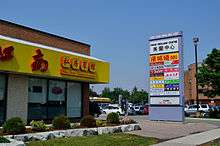
Agincourt, a Scarborough neighbourhood, saw an influx of Hong Kong Chinese and Taiwanese during the 1980s, especially around Sheppard Avenue and Midland Avenue. Since the development of Agincourt's Dragon Centre Mall in the 1980s, it has become a booming "Chinatown" and was the vanguard for the proliferation of "Chinese malls", large malls with restaurants and stores catering specifically to the Chinese community, across the GTA.
Since 2000, the Agincourt Chinese population is spread thinly and many are leaving for communities north of Toronto. Pockets of Chinese areas are likely to remain, but they will be less vibrant when compared to the late 1980s and early 1990s.
Chinese malls in the Agincourt area:
- Oriental Centre
- Dragon Centre
- Chartwell Centre
- Milliken Square
- Milliken Crossing
- Finch Midland Centre
- Midland Court
- Silverland Centre
- Scherwood Centre
- Midland Village
- Cathay Plaza
- Prince Mall
- Mandarin Shopping Centre
- Pearl Place
- Milliken Wells Shopping Centre
- Chartwell Shopping Centre
- Centreview Square
- Regency Court
- Splendid China Mall
North York
The former city is home to large pockets of Chinese immigrants, but there are only a few malls serving it and mostly located in the east end. The smaller plazas containing restaurants and supermarkets have proliferated in the 1980s at the Finch Avenue/Leslie Street intersection, Keele Street and Sheppard Avenue, and around Victoria Park Avenue and McNicoll Avenues. These often compete with and complement the Agincourt Chinatown. The Finch-Leslie plaza is still thriving, because of the relative wealth of North York, though its patronage has now diversified. However, the gradual departure of the northern Scarborough Chinese clientele has led to the decline of businesses around Victoria Park and McNicoll.
- Finch Leslie Square
- Victoria Business Centre 3600 Victoria Park Avenue
Mississauga
Mississauga's growing Chinese population is spread out across the vast suburb, but the commercial community has been traditionally centred on the Chinese Centre, located at 888 Dundas Street East, just east of Cawthra Road. This large complex, built in the late 1980s, was constructed to reflect China's cultural heritage; an elaborate gate greets visitors on Dundas Street, with a Nine Dragon mural just inside, while red towers with pagoda-styled roofs abound. Growth of this Chinatown is limited, but Mississauga's Chinatown remains an active community.
The second newer stretch includes markets and restaurants in strip mall plazas close to the intersection of Burnhamthorpe Rd. West at Central Parkway (near the Erindale GO Station) which remains in the growth phase catering mostly to the needs of the growing Chinese population in the city who live nearby.
Chinese malls in Mississauga:
- Mississauga Chinese Centre/Sino Mall
- Golden Plaza
- Golden Square Centre
- Dixie Park
- The Chase Square
- Newin Centre
- Erindale Business Centre
- Deer Run Shopping Centre
Richmond Hill
During the 1990s, wealthy Chinese immigrants, primarily from Hong Kong, moved directly to suburban Richmond Hill, where they set up businesses and shops catering to that community.
Many shops and restaurants were established in suburban-style shopping malls and plazas (such as Times Square) along a stretch of Highway 7 between Bayview Avenue and Leslie Street. The most intense development is concentrated around the Commerce Valley Drive/Beaver Creek Road loop. Some of the well-known higher end Chinese banquet restaurants are in this area. Consequently, some colloquially use the term "Highway 7" to refer to the newly established Chinatown there.
There are similarly thriving Chinese plazas in Markham several kilometers east on Highway 7, and many families often visit both communities on the same day.
Chinese malls and plazas in the Richmond Hill area:
- Times Square
- Wycliffe Village
- Shoppes of the Parkway
- Ho-View Place
- Lexus Bayview Square
- Goldenview Centre
- Jubilee Square
- Richlane
- Glen Cameron Place
Markham
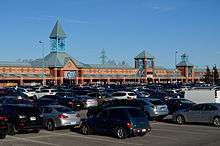

Markham's experience as a suburban Chinatown is similar to that of neighbouring Richmond Hill and emerged in the 1990s, though the developments are less intensively developed and more spread out through the municipality.
On Highway 7, between Woodbine and Warden Avenues, is First Markham Place, containing numerous shops and restaurants; this is several kilometers east of Richmond Hill's Chinese malls. Further east along Highway 7 is an older plaza is at the southwest quadrant with the intersection with Kennedy Road.
The most well-known Chinese mall in Markham is the Pacific Mall, at Kennedy Road and Steeles Avenue East, which, combined with neighbouring Market Village Mall and Splendid China Mall, forms the largest Chinese shopping complex in North America, with over 700 stores between the three malls. In close proximity, at Steeles East and Warden Avenue, there is the New Century Plaza mall and a half-block away there is a plaza of Chinese shops anchored by a T & T Supermarket.
Markham itself has the largest proportion of Chinese among all the GTA municipalities. In the 1980s and early 1990s, then-Mayor Tony Roman was leading trade delegations to Asia in which he promoted Markham as a great place to live and invest. While influx new immigrants brought many jobs and much wealth to the areas they settle, their presence and "Chineseness" became a target of racial intolerance from some. In 1995, Deputy Mayor of Markham Carole Bell argued that the concentration of ethnic groups were a cause of social conflict, saying "the weakness of it comes when there is a concentration, when you are getting only one group of people". She went on to say "everything’s going Chinese" in Markham, stating that they were driving away the "back bone of Markham away...the people who run festivals, coach our kids, organize our business communities, Brownies, Guides, Scouts." In response, the twelve mayors of the Greater Toronto Area signed a letter dissociating themselves from Bell’s comment.[14]
Chinese malls and plazas in the Markham area:
- First Markham Place
- Warden Centre
- Commerce Gate
- Metro Square
- New Century Plaza
- Peachtree Centre
- Newton Centre
- Pacific Mall
- Market Village Mall
- Langham Square
- Denison Centre
- King Square Shopping Mall
- Alderland Centre
See also
- List of Chinatowns
- Chinese in Toronto
- Agincourt, Toronto - usually considered Toronto's second Chinatown
- List of neighbourhoods in Toronto
- Standard Theatre
References
- 1 2 3 4 5 6 7 Yee, Paul (2005), Chinatown: An illustrated history of the Chinese Communities of Victoria, Vancouver, Calgary, Winnipeg, Toronto, Ottawa, Montreal and Halifax, Toronto, ON, CAN: James Lorimer & Company Limited
- ↑ "Toronto's First Chinatown". "The first Chinese resident recorded in Toronto was Sam Ching, the owner of a hand laundry business on Adelaide Street in 1878."
- ↑ "Toronto Tourism: Chinatown". "Sam Ching was the first Chinese person to be listed in the city directory"
- ↑ City Surveyor. "Naming of Public Lanes Bounded by Yonge Street, Queen Street East, Parliament Street and the Railway Corridor" (PDF). Staff Reports. City of Toronto. Retrieved 22 March 2014.
- ↑ Scheinberg, Ellen; Yee, Paul (7 June 2015). "Life in the Ward". The Toronto Star. Retrieved 7 June 2015.
- ↑ Changes to Toronto’s Chinatown: Toronto's First Chinatown and Downtown Chinatown, Paul Qiu
- 1 2 3 4 5 "Toronto's early Chinese restaurants attracted both gourmets and goons". Toronto Star. June 7, 2015. Retrieved July 19, 2015.
- ↑ "Old Chinatown". "By 1930, the number of laundries declined to 355; a loss of 116 from 1923. Restaurants also suffered a drastic reduction to only 104 in 1930."
- ↑ http://www.thestar.com/amp/life/2016/05/11/japanese-influence-is-seeping-into-downtown-toronto.html
- ↑ http://torontoist.com/2016/02/shaping-toronto-chinatowns/
- ↑ "11 people rescued as East Chinatown blaze destroys building". CTV Toronto. 13 July 2013.
- ↑ http://www.achristmasstoryhouse.com/index.php/filming-locations/bo-lings-chop-suey-palace/
- ↑ Persaud, Nadia. "Chinatown comes to life on Scarborough big screen." Toronto Observer. November 22, 2010. Retrieved on August 22, 2013.
- ↑ "The Carole Bell Incident". Chinese Canadian National Council Toronto Chapter.
External links
| Wikivoyage has a travel guide for Kensington & Chinatown. |
| Wikimedia Commons has media related to Chinatown, Toronto. |
- Chinatown Business Improvement Area
- City of Toronto – Chinatown BIA
- Local Chinese History at the City of Toronto Archives
 |
Harbord Village |  | ||
| Kensington Market, Alexandra Park, Toronto |
|
Baldwin Village, Grange Park | ||
| ||||
| | ||||
| Entertainment District |